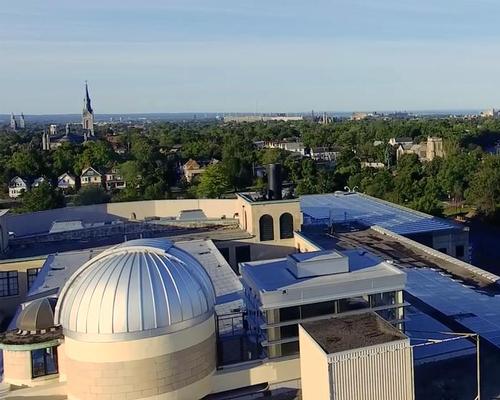17 Jul 2018
Buffalo Museum of Science reopens renovated observatory after 19 years
BY Tom Anstey

The Buffalo Museum of Science in Buffalo, New York, has celebrated the opening of its new digital planetarium, following the redevelopment of its Kellogg Observatory.
The observatory, which reopens to the public for the first time in nearly two decades, has undergone major renovations.
Part of the museum's history for close to a century, the observatory – along with its historic Lundin telescope and rooftop area – have undergone an extensive update and restoration.
Opened in 1930, the observatory closed in 1999 due to the need for repairs. It also featured outdated equipment and offered limited accessibility to visitors.
HHL Architects was appointed architect partner for the project, with Picone acting as construction contractor. As part of its restoration, the observatory's 90-year-old telescope has been fully restored, with the object sitting under a new aluminised steel dome. The redeveloped roof deck and dome pier are also now available for all museum guests.
In addition to its physical transformation, the museum has also undergone a rebranding, introducing a new logo and tag line – "Find Why" – which will rooted in the idea of asking 'why'?
"The Kellogg Observatory and its iconic silhouette have been dormant for almost two decades, and we’re thrilled to now open the skies to a new generation of explorers," said Marisa Wigglesworth, president and CEO of the Buffalo Society of Natural Sciences.
"Not only does the Kellogg Observatory provide a unique science learning destination for local and regional stargazers, but it solidifies the Buffalo Museum of Science’s place as a leading resource for astronomy for our region."
With the launch of the redeveloped observatory, the museum has also debuted a new portable planetarium, which can travel to destinations such as schools and community centres, increasing local outreach for the science museum.
Capable of fitting about 20 people at a time, visitors can explore the solar system in the inflatable planetarium, with a 360 degree view of stars and their constellations. The planetarium also features a range of digital overlays, enhancing use for multiple functions.
The observatory's reopening marks the completion of the science museum's "See It Through" capital fundraising campaign, which since 2012 has raised more than US$8m (€6.8m, £6m) towards redevelopment costs. In that time the museum has also undergone its own transformation, with its permanent gallery spaces becoming interactive, changeable education spaces that combine technology with pieces from the museum’s collection.
Close Window